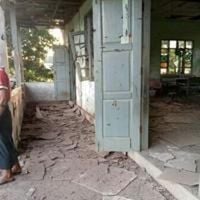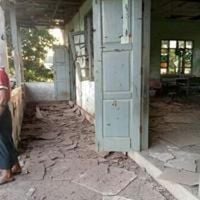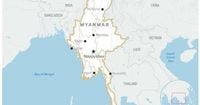On the evening of October 6, 2025, the tranquil village of Bon To in Myanmar’s Sagaing Region became the scene of one of the deadliest attacks on civilians since the military coup of 2021. What was meant to be a peaceful celebration of the Buddhist Thadingyut festival—a time for light, prayer, and hope—was shattered when Myanmar’s military used motorized paragliders to drop bombs on a gathering of more than 100 villagers, including children, elders, and activists. The result was a tragedy that has sent shockwaves through the country and drawn condemnation from human rights organizations and the international community alike.
According to multiple independent media reports, including BBC News, The Irrawaddy, and the Associated Press, the attack occurred as villagers assembled at the primary school compound in Bon To, about 10 kilometers from Chaung-U Township. They had come together for a traditional oil lamp prayer ceremony to mark the Full Moon Day of Thadingyut, one of Myanmar’s most sacred Buddhist holidays. This year, however, the festival had taken on added significance: it doubled as a candlelight vigil and peaceful protest, calling for the release of political prisoners—most notably Aung San Suu Kyi, the country’s ousted leader—and condemning the military’s controversial plan for an upcoming election.
Eyewitnesses described a scene of horror and confusion as the first bombs fell at around 8 p.m. “Children were completely torn apart,” one of the event organizers told AFP, as cited by BBC News. The bombs, believed to be 120 mm mortar rounds, scattered victims’ bodies and made it nearly impossible to identify the dead. A local resident recounted to The Irrawaddy, “To my knowledge, 32 people were killed, including five from [the non-violent movement and the resistance fighters who protect the area]. The rest are civilians. Fifty people were injured.” The paragliders returned minutes later to drop two additional bombs, further compounding the devastation.
The death toll remains uncertain, with estimates ranging from 19, according to the opposition National Unity Government (NUG), to at least 32 as reported by The Irrawaddy. Some resistance fighters put the number even higher, suggesting between 20 and 40 fatalities. More than 50 people were confirmed wounded, many with severe injuries such as broken or missing limbs. As a resident told Mizzima, “There are serious concerns about the condition of the injured, so the death toll may rise.”
Myanmar’s military government, in a statement released two days after the attack, acknowledged responsibility but deflected blame onto resistance forces. The military accused its opponents of “using civilians as human shields in their anti-government incitement campaigns,” asserting that the operation was a counterterrorism measure designed for “minimal civilian casualties.” However, both local witnesses and resistance members who attended the vigil rejected these claims outright, insisting that the gathering was voluntary and peaceful. No armed combat was reported near the scene at the time of the bombing.
The United Nations weighed in swiftly. A spokesperson for Secretary-General António Guterres declared, “The indiscriminate use of airborne munitions is unacceptable.” This sentiment was echoed by Amnesty International, whose Myanmar researcher Joe Freeman stated, “The sickening reports emerging from the ground in central Myanmar following a nighttime attack late on Monday should serve as a gruesome wake-up call that civilians in Myanmar need urgent protection. The international community may have forgotten about the conflict in Myanmar, but the Myanmar military is taking advantage of reduced scrutiny to carry out war crimes with impunity.”
The attack on Bon To is not an isolated incident, but rather the latest in a series of increasingly frequent and brutal airstrikes by the military since it seized power in February 2021. The junta has been steadily increasing its use of air power, especially as it loses ground to resistance groups in key regions like Sagaing. The use of motorized paragliders to drop bombs is a relatively new tactic, one that Amnesty International speculates may be related to shortages of jet fuel for fighter jets—a consequence of international efforts to restrict the junta’s access to such resources.
The timing of the attack has also raised suspicions about the military’s motives. The NUG has accused the junta of ramping up violence in the lead-up to its planned election, scheduled to begin on December 28. “The regime continues to pressure for an illegitimate election while escalating violence and human rights abuses against the people, coercing and terrorizing citizens in connection with the electoral process,” the NUG’s Ministry of Human Rights said in a statement. They further pledged to “exert all efforts to hold them accountable.”
Sagaing Region, where Bon To is located, has emerged as a stronghold of armed resistance since the coup. What began as peaceful protests against the military takeover quickly escalated into armed conflict after the junta responded with lethal force. Today, the region is largely controlled by volunteer militias and resistance fighters, many of whom are loosely connected under the nationwide People’s Defense Force. The military’s crackdown has been harsh: according to the Assistance Association for Political Prisoners (AAPP), as of October 9, 2025, at least 7,360 people involved in pro-democracy movements have been killed, and nearly 30,000 have been arrested. These figures, the AAPP notes, are likely underestimates, as many deaths go unreported or unverified.
The violence has taken a heavy toll on Myanmar’s diverse population. About 90 percent of citizens identify as Buddhist, but Christians, Muslims, Hindus, and other religious minorities have also faced repression. Even the country’s revered Buddhist monastic sangha has not been spared, with monks and nuns targeted in military crackdowns and sometimes even killed or detained.
Internationally, the junta’s actions have drawn widespread condemnation, but little effective intervention. The military has sought to bolster its capabilities with new drones from China and technical assistance from Russia, according to independent media reports. Meanwhile, the Association of Southeast Asian Nations (ASEAN), currently chaired by Malaysia, has struggled to mediate a path to peace. On the same day as the attack, Malaysia’s Foreign Minister Mohamad Hasan met with Senior General Min Aung Hlaing, the junta’s leader, to discuss the upcoming election and humanitarian aid, but no breakthrough was reported.
For the survivors and families of Bon To, the scars—both physical and emotional—will not heal easily. Videos of the aftermath, showing people screaming, crying, and searching for loved ones amid the rubble, have circulated widely on social media, fueling outrage and despair. As Myanmar heads toward its controversial election, the memory of October 6 will linger as a stark reminder of the human cost of unchecked power and impunity. The world, it seems, is once again being asked to reckon with the consequences of looking away.






